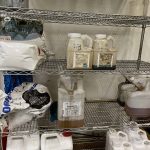It’s the End of the Lawn Care Season, Now What?After one final cut, you can put your mower away until spring time. However, there is still some work that needs to be done; to ensure you have a healthy lawn after Father Winter departs in a few months from now.
There is a misconception about turf grass. It is assumed by many who are not lawn fanatics that brown grass equals dead grass. This can be true during the growing season; especially spring and early fall; it is not the case during the winter. Grass is still very much alive even while it appears brown during the cold months. Cool season grass types are acclimated to the temperature swings we have in the Mile High City. Once the temperatures drop enough, your lawn will know that it is time to become dormant to preserve energy for when ideal conditions return. So while the shoots of grass above ground are brown and scraggly, the root system is still intact and waiting patiently for spring to return the soil temperatures over 50 degrees Fahrenheit.
All that being said, you must treat your lawn like the living thing that it is. This will heighten your chances of having your grass grow back seamlessly next year.
Take Measures to Prevent Snow Mold
Throughout our winters here in the Denver Metro we are likely to experience heavy dumps of snow at least a few times. While these snow falls can leave a beautiful blanket of white on your lawn, it can also affect your lawn negatively when the combination of moisture and soil temperature create a breeding ground for snow mold.
Snow mold is a fungus that primarily affects cool-season grasses. The lawns that are most at risk for being ravaged by this fungus are those that have piles of leaves, grass that was left to grow out too long before dormancy. The snow weighs down these grass blades, leaves, or whatever other debris may be on your lawn. This causes the root system below to suffocate and become weak. A poor root system can be easily overcome with disease. All the while there is also moisture that becomes trapped in the debris that cannot dry out even when the rest of the snow has melted away and evaporated. It’s important to rake up any leaves and mow your grass short before the first frost.
The scariest part of all this is that you won’t even know if your lawn is suffering until spring. Snow mold appears as straw colored circular patches within your lawn as it comes out of dormancy. Unfortunately once the damage is done you cannot apply a fungicide. The snow mold fungicides available are all preventative and do nothing to repair affected grass.
If you are an unlucky lawn lover whose lawn succumbed to snow mold, there is hope. Snow mold cannot continue to harm your lawn into the growing season, you just need to remove the dead patches left behind and start fresh. Getting a head start on building back that healthy root system will be key to a successful lush green lawn. As soon as you notice snow mold damage, get an aeration and lay down some seed. Thickening up the dead areas with new grass early on will give your lawn an advantage over weeds, disease, insects, and any other nuisance that could come your way throughout the growing season.
If you need a professional set of eyes on your lawn to ensure it bounces back from any damage it received over the winter. Contact Erbert Lawns today to get set up for all your lawn care needs for 2022.










